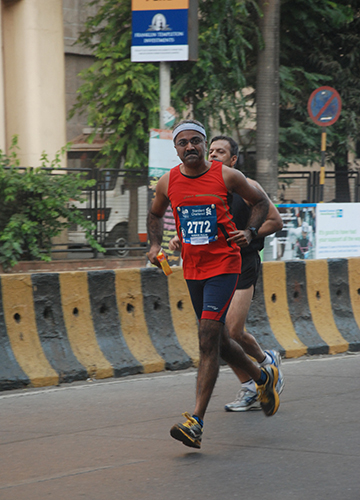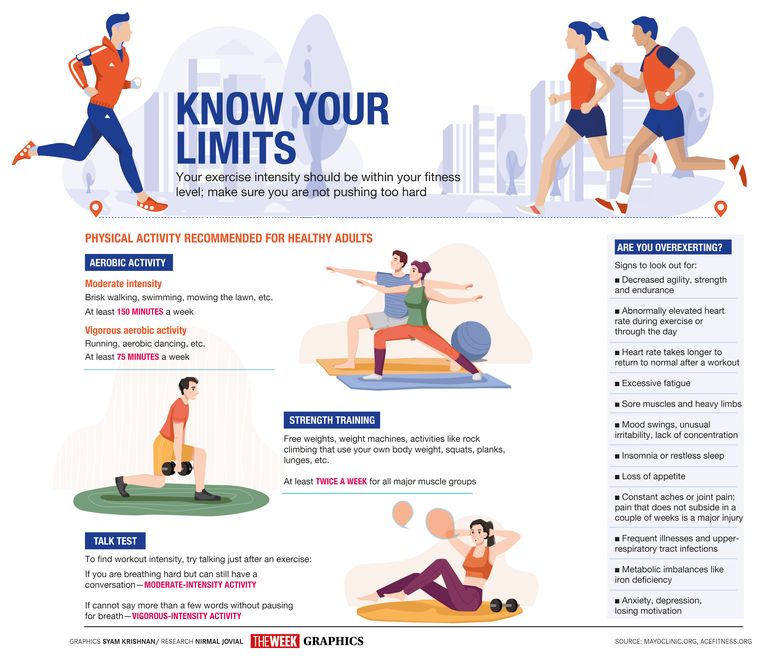In barely two months, India lost two very popular and celebrated actors—Puneeth Rajkumar from the Kannada film industry and Sidharth Shukla from the Hindi film industry and a Big Boss winner. Both were in their 40s, gym regulars and advocates of fitness. Yet, both died a sudden cardiac death; they died before they could be admitted to hospital. Neither of them suffered from pre-existing conditions. A similar death was that of Raj Kaushal, Bollywood director and husband of actor Mandira Bedi. Kaushal was 49 when he suffered a “sudden heart attack”. He, too, was known for his “active lifestyle”.
Each of them had complained of “chest pain” a few hours after their workout, and that has led to several questions. Did the workout have anything to do with it? Did the body undergo exertion caused by 'over-exercising', which then led to a heart attack? How can someone in the prime of one’s life and a fitness buff die of heart attack, which was hitherto mostly seen in the older population and those leading sedentary lifestyles? Medical experts and scientists all agree that exercise in itself cannot be blamed for tragic clinical outcomes, and that it is mainly the “yearning for pushing the body undesirably to test its limits often as an outcome of social pressure” that is at the crux of the problem.
According to Dr Vivek Jawali, chief of cardiothoracic vascular sciences, Fortis Hospitals, one thing that could have happened in Rajkumar’s case was that hardcore exercising could have ruptured his arteries. “For instance, if you have soft to moderate plaques in your arteries, then exercising very hard can lead to spiking of the heart rate, contractile force and blood pressure, which, in turn, can lead to friction of the fast-flowing blood on the arteries and rip them open,” he says. He, however, adds that in Puneeth’s case the heart attack did not come as a major surprise as he had a family history of heart disease. “His brother Raghavendra had come to us at 23 because of a heart attack. His father, Dr Rajkumar, was treated by us for many years for the same problem.”
This June, Danish footballer Christian Eriksen suffered a cardiac arrest and collapsed on field during Denmark's opening Euro 2020 match. The footballer got a miniature defibrillator fitted to detect and correct heart rhythm disorders.
A cardiac arrest, say experts, occurs when the heart stops completely, rendering the person unconscious. A heart attack, on the other hand, is a condition that slows down blood circulation, and the patient may stay conscious.
“We have always had young patients coming to us due to heart attacks caused during and after physical exercises, and a lot of them have been extremely fit also,” says Dr Sudhir Pillai, consultant cardiologist, Hinduja Hospital. He explains that physical fitness may not always be the same as “biological fitness”. The body, he says, does not care about physical fitness, it is about how healthy you are metabolically. He cites three important reasons for young patients to get sudden cardiac arrest—one, owing to a heart attack when the arteries shut down; two, because of arrhythmia when the heart becomes very fast due to underlying heart disorder; three, arterial dissection, where because of the sheer physical or emotional stress, including sudden heavy exercises, the walls of the artery pop.
The moment we cross the age of 20-25 years, says Pillai, we all have these small cholesterol deposits or plaques in our arteries, which may build up over time. Plaque rupture can happen because of extreme physical stress that one is otherwise not conditioned to, or owing to extreme emotional stress and biological stress such as acute infections.
“It takes long years for fitness to be established,” says Pillai. “It is one that begins in childhood and goes on into adulthood. It is worth noting that these kinds of sudden cardiac deaths are not observed much in rural areas or in the labour class or farmers or tribals who have all been doing physical work for years.” For people who take up physical exercise in their 30s and 40s, Pillai’s advice is to give the body time to adapt. “One cannot suddenly start running marathons in short timelines by giving in to peer pressure,” he says. “That can lead to the plaque rupturing and sudden cardiac arrest. Also, those who may be into exercises and fitness for long, but decide to stretch their limits further, for instance, suddenly moving from 20km daily to 40km on a single day will sense trouble at some point. Sheer exhaustion can create either a plaque rupture or dissection of the artery. So please take it slow.”
Mahesh Ambekar, a fitness trainer who runs a gym in Mumbai, narrates the tragic death of a 40-year-old owing to sudden cardiac arrest while working out in his gym. “He was a regular and was on top of his game,” he recalls. “On that particular day, he overdid it with weights and cardio. In his thrill for testing the limits of his body, he took up deadlifts that were close to 100kg, something he had never attempted before. I think that did it. It was just all of a sudden and we had no time to act.”
‘Ego-lifting’, says Ambekar, is the cause of most injuries and even death inside the gym. “One of my clients was doing leg press, which helps in building the quadriceps and hamstrings of the thigh and buttocks,” he says. “He was a gym regular and knew his regimen well. Yet, he went overboard with the weights. While he ideally had to take 180-200kg, he took 350-400kg weights simply as a way of massaging his own ego and ended up with a broken shinbone, which carries the majority of the body's weight.”
Experts agree that extreme exercise can be toxic to the heart. As per a 2018 research report titled, 'Characteristics and prognosis of exercise-related sudden cardiac arrest', published in Frontiers in Cardiovascular Medicine, while physical activity is an established protective factor for coronary heart disease, stroke and heart failure, and may also reduce the risk of sudden cardiac death in the general population, “those who suffer sudden cardiac arrest in association with physical activity tend to be younger and previously healthier”. As per the report, cycling and heavy physical labour were the most common types of physical activity related to sudden cardiac arrest. Reports have also emerged that say putting in excessive running miles, such as ultra marathons, may lead to conditions that may promote cardiac rhythm disturbances.
Over-exercising effects go beyond the heart. Dr R.H. Chauhan, orthopaedic surgeon at Bhatia Hospital in Mumbai, says that he regularly gets patients with knee pains, backaches and muscle tears, either because they go overboard on the treadmill or lift excess weight or indulge in too much strength training in the gym too soon.
Gym trainer and fitness enthusiast Snehal Thevan, who has been training at a gym in Mumbai's Kurla for over seven years now, cites the example of a “fitness freak who overdid it with squats” The man, in his early 40s, did squats with dumbbells weighing over 90kg. “He should have stuck to 40-50kg,” she says. “But because he went overboard, he got a slip disc when he tried getting back up.”
Over-exercising or going overboard with workouts can mean different things to different people, says Chauhan. For somebody who has never exercised in his or her life, overdoing it can mean suddenly indulging in excess workout just for the kick of it. “The legs and the hands stop growing between the ages of 14 and 16 years and the spine stops growing at the age of 22,” says Chauhan. “So that is why any kind of weight-lifting exercise before the age of 18 is not recommended because it can affect one's growth. The most decisive indicator of overdoing it in a gym is the repetition level of a workout. How many times do you do the same exercise over and over again? And, is it too much too early? If the answer to that is a yes, then you are sure to experience muscle fatigue, muscle spasm and muscle tear, and laxity, looseness and injury to the ligaments.”
Chauhan recounts the case of a man who started working out in his early 30s. “He began with 40 reps of every exercise in the gym, right from strength training to weights to squats, instead of taking it slow with 10 reps at the start,” he says. “That alone became the reason for soreness in his muscles and it had a major impact on his knees.”
Also, while lifting very heavy weights, one can injure the body. “You can sprain any joint during weightlifting, starting from the ankle, lower spine, middle spine, upper spine and elbows,” says Chauhan. “A spinal vertebral fracture, resulting from excess weightlifting, is a high possibility, too.” He cites the example of his friend, also an orthopaedic surgeon, who recently fractured his spine and was bedridden for three days because of overdoing the bent-over-rows exercise.
Another example of overdoing it among teenagers is going on a 12km hike with friends all of a sudden with no previous workout routine. Treadmill-related knee injuries that cause wear and tear of joints are the most common gym injuries, and long-term treadmill use in the wrong fashion can even increase the risk of arthritis, says Chauhan. Most of his patients are in the age group of 20 to 40 years who cannot wait to lose weight and build up their muscles and stamina. They want to see the results in a matter of days and that is exactly when things begin to go wrong, he says.
So, just how much exercise is too much exercise? We cannot tell for sure, just yet. “There is no pre-defined limit because the science around over-exercising is simply not enough,” says Dr Aashish Contractor, director of rehabilitation and sports medicine at the Reliance Foundation Hospital, Mumbai. “We have not conclusively proven that too much exercise is bad and what the cutoff point is.”
Aanchal Gupta, who runs the Arts in Motion studio in Mumbai that focuses on freestyle exercises, says that exercise, even if strenuous, will offer more benefits than risks and only a small minority of those who may be having underlying problems might experience arrhythmia.
Agrees Pillai: “There is no doubt that pushing one's body to its maximum every day can stress the heart and raise the risk for arterial fibrillation, a type of abnormal heart rhythm that can lead to heart failure or stroke. But it is important to know that not exercising at all is far worse for the heart than overdoing it, because not getting the blood pumping can lead to clogged arteries and so moderation is key.” The Centers for Disease Control and Prevention recommends that adults get at least 150 minutes of moderate exercise per week to help ward off unhealthy weight gain and heart disease.
Jawali notes that heart attack cases among Indians below 50 years doubled in the last 20 years, and such cases increased by 25 per cent among those under 40. A similar trend is noticed among urban women, too. “The problem is a mixed bag of genetic predisposition toward heart attack, which is almost three times more among southeast Asians than among whites and blacks,” says Jawali. “This has been compounded by a dramatic change in lifestyle.”
While in the US, a number of athletes and fitness enthusiasts die of sudden cardiac deaths resulting from heart attacks because of irregularity of heart rate, young Indians are dying because of accumulated plaque in their arteries and not irregular heart rhythms, explain doctors. These small plaque lesions collected over time due to sedentary lifestyles will become blocked by the time one is 60, say doctors.
“It is not the exercise that is getting people into trouble,” says Pillai, “it is the manner in which the body is put to test during exercise which is the problem. One has to understand the limits of one's own body and follow a structured form of exercise and watch for signs of over-exercise. The most common way of finding it is [to check if your] heart rate is high and [if you] are not able to eat well [in the morning]. Take a break. For instance, after six weeks of good running, take one week off.”
Another problem that Thevan has observed is fitness enthusiasts overdoing one particular workout. For instance, somebody who enjoys treadmill spends more than an hour on it while neglecting the other elements of the body. “This type of overtraining presents itself as knee pain, soreness in the legs and also a sort of exhaustion,” she says. The solution lies in diversifying one's workout routine, she adds.






